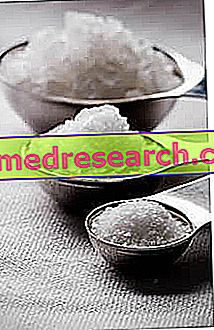Sodium
Sodium (as opposed to potassium) is the main EXTRAcellular cation. It is found in the body in quantities of about 92 grams, of which:
- 50% is located in the extracellular interstices
- about 12.5% in intracellular fluids
- about 37.5% inside the skeleton

Sodium is introduced through feeding in an almost continuous and scarcely selective manner, since it is a widely diffused ion in food; moreover, it is highly absorbable, especially near the small intestine and the colon.
The homeostatic maintenance of sodium (like that of other electrolytes) occurs above all thanks to renal control; specifically, the mineral undergoes a tubular reabsorption that is facilitated or inhibited (0.5-10% oscillation) by hormonal regulation mediated above all by aldosterone, an adrenal secretion hormone produced in the glomerular region of the cortical portion of the adrenal gland.
The only "inevitable" losses of sodium are made up of faeces, sweat and mucus (the latter of marginal importance), but in the face of a tendentially hypersodic diet, therefore very rich in sodium, such losses constitute only 7% about the daily intake (with the due differences in sports). During pregnancy and lactation, taking into consideration the average nutritional habit of Italians, despite the increase in requirements, it does not seem necessary to supplement the amount of sodium food.
Sodium deficiency
Sodium deficiency is extremely rare. It may be induced by low-dose diets and / or abnormal sweat leaks and / or renal lesions and / or chronic diarrhea; more frequently from the association of more factors. A serious deficiency of sodium inevitably leads to the alteration of the nerve conductivity, of the acid base balance and probably of the extra cellular oncotic pressure.
Excess sodium
On the other hand, the excess of sodium, even if of unlikely toxicity, determines an increase of the extracellular pressure with consequent retention of liquids as maintenance reaction of the natural extracellular chemical concentration; moreover, the possibility that in the long term a similar condition may originate indiscriminate edematous syndromes of the interstices (water retention) is not excluded. At the same time, the excess of sodium in food correlates positively with the incidence of arterial hypertension and with the maturation of osteoporosis (see: salt, sodium and osteoporosis).
Sodium and hypertension
As already stated, the excess of sodium food determines (especially in sensitive subjects) the appearance of arterial hypertension. This statement is widely justified and demonstrated by numerous population studies and clinical trials that highlight a direct and proportional correlation between the two factors.
Other variables that often accompany a bad diet positively influence the appearance of hypertension; these risk factors include obesity, hyperglycemia and diabetes, the metabolic syndrome, the poor quality of dietary fats (too many saturated and a few omega-3), alcohol abuse, smoking, the nutritional lack of potassium and magnesium, a sedentary lifestyle and psychological stress.
It should be pointed out that hypertension is indeed a potentially increasing disease, however, given the CONTINUITY of the relationship between sodium and hypertension, it is also possible to state that sodium dietary restriction can improve / decrease arterial blood pressure in hypertensive subjects, but also in healthy subjects. In light of this, it is evident that the complete abolition of the added food sodium (NOT naturally contained in food) would also drastically reduce mortality due to acute vasculopathies.



